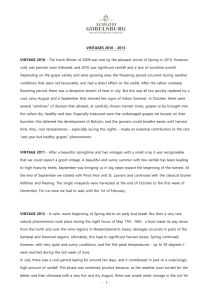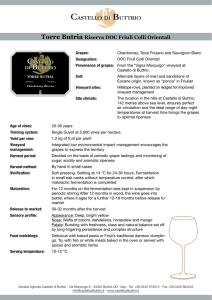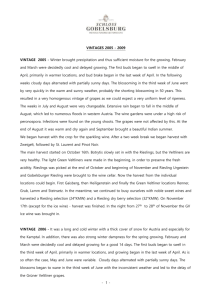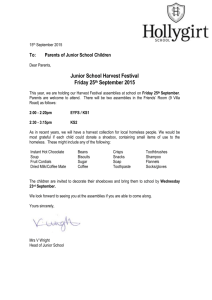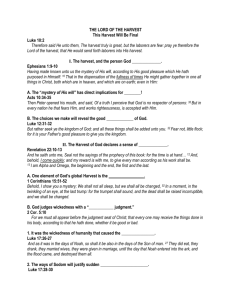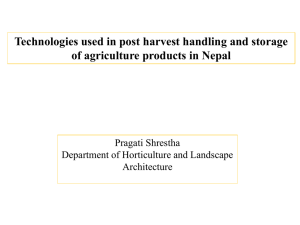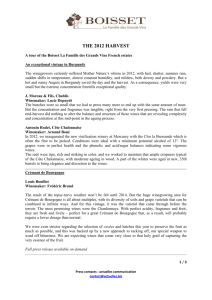vintages 2000
advertisement
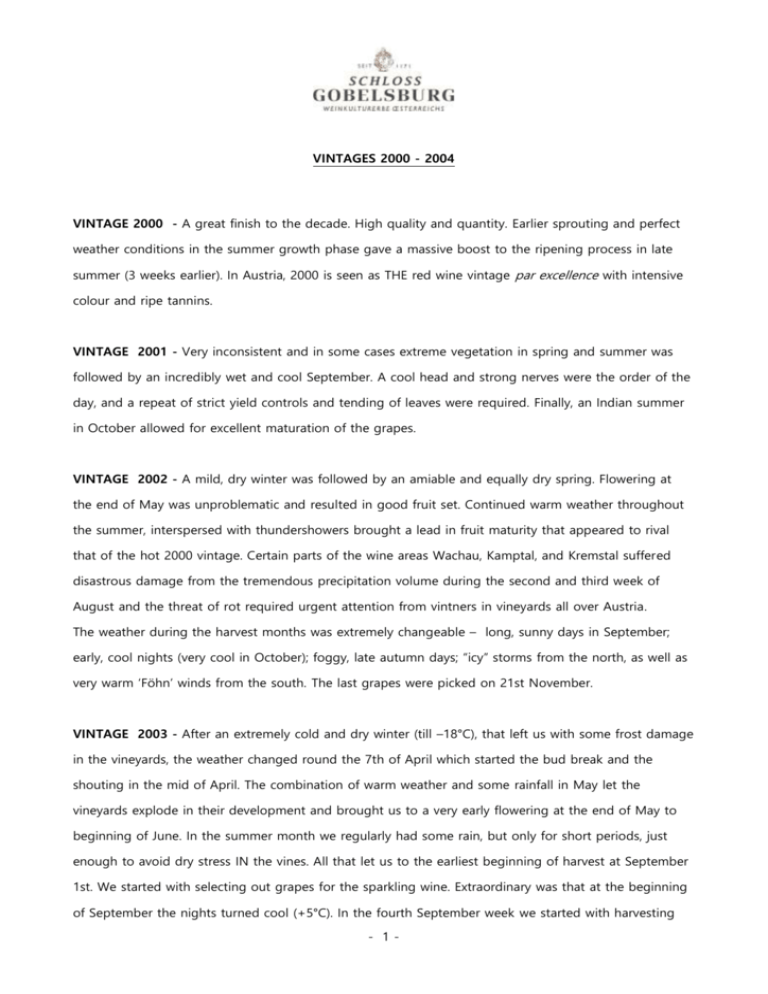
VINTAGES 2000 - 2004 VINTAGE 2000 - A great finish to the decade. High quality and quantity. Earlier sprouting and perfect weather conditions in the summer growth phase gave a massive boost to the ripening process in late summer (3 weeks earlier). In Austria, 2000 is seen as THE red wine vintage par excellence with intensive colour and ripe tannins. VINTAGE 2001 - Very inconsistent and in some cases extreme vegetation in spring and summer was followed by an incredibly wet and cool September. A cool head and strong nerves were the order of the day, and a repeat of strict yield controls and tending of leaves were required. Finally, an Indian summer in October allowed for excellent maturation of the grapes. VINTAGE 2002 - A mild, dry winter was followed by an amiable and equally dry spring. Flowering at the end of May was unproblematic and resulted in good fruit set. Continued warm weather throughout the summer, interspersed with thundershowers brought a lead in fruit maturity that appeared to rival that of the hot 2000 vintage. Certain parts of the wine areas Wachau, Kamptal, and Kremstal suffered disastrous damage from the tremendous precipitation volume during the second and third week of August and the threat of rot required urgent attention from vintners in vineyards all over Austria. The weather during the harvest months was extremely changeable – long, sunny days in September; early, cool nights (very cool in October); foggy, late autumn days; “icy” storms from the north, as well as very warm ‘Föhn’ winds from the south. The last grapes were picked on 21st November. VINTAGE 2003 - After an extremely cold and dry winter (till –18°C), that left us with some frost damage in the vineyards, the weather changed round the 7th of April which started the bud break and the shouting in the mid of April. The combination of warm weather and some rainfall in May let the vineyards explode in their development and brought us to a very early flowering at the end of May to beginning of June. In the summer month we regularly had some rain, but only for short periods, just enough to avoid dry stress IN the vines. All that let us to the earliest beginning of harvest at September 1st. We started with selecting out grapes for the sparkling wine. Extraordinary was that at the beginning of September the nights turned cool (+5°C). In the fourth September week we started with harvesting - 1- the red burgundy varieties (Pinot Noir, St. Laurent, Zweigelt). After October 2nd we stopped harvesting for two weeks. We had to wait for the complete physiological ripeness of the grapes. Ripeness is not sugar level – that turned out to be one of the key factors of the vintage. Sugar levels did not change much between end of September and end of October. But if went through the vineyards and tasted the grapes, you could taste the difference from week to week. Then in the third week of October be could start with the cooler sights for the light GV’s, then we picked the Rieslings from Gaisberg and Heiligenstein and then the single vineyards from Steinsetz, Renner, Grub and Lamm. On the 6th of November – two weeks earlier then in the previous years – harvest could be completed. VINTAGE 2004 - For once there were no frost damages during winter. However, February and March were rather cool and we could assume a “late harvest” already at this early time of the year. As late as mid of April the first buds showed on vines situated in warm and shielded sites and began to fully sprout in last week of April. Cool weather continued, overcast and sunny spells alternating. Heavy precipitation caused another delay in vegetation. Vines blossomed from mid of June to early July, but many buds did not completely finish flowering hence bearing no fruit. This is ideal for the wine grower, that is to say less green harvest. But it also means a late harvest. July and August turned out to be extremely dry and sunny. The vineyards developed beautifully. Two rainy days end of August gave the first glance of autumn. September was dry but cool. Harvest started on September 19 that is, as always, with grapes for the base wine of our sparkling “BRUT”. The berries produced a natural ripeness of 11% - just right for a clear structure and ideal blend of Pinot Noir, Gruener Veltliner, and Riesling which are the components of the Gobelsburg Brut. After 10 days of intermission the harvest of red varieties began. First Zweigelt, then St. Laurent, and later Pinot Noir. The hot days of July and August produced well coloured skins of the berries whereas the cool September strengthened subtle fruit notes. Main harvest started on October 19. On lower vineyard sites white frost that occurred on October 12 changed colours of the foliage. Partially leaves fell off and grapes hung freely on the vines. Mist and fog delayed the harvest again. Long intervals were needed to let the grapes dry off. Foehn warmed up days and nights considerably which gradually caused Botrytis. Fortunately on November 11 the weather changed to the better. It turned out to be very cool, dry, and windy. Grapes dried off quickly and one could taste the difference day by day. Now it was an excellent - 2- time to harvest the single site varieties. First Riesling Gaisberg, then Heiligensstein, followed by Gruener Veltliner Renner, Grub, Lamm, and Steinsetz. The last two days of a difficult but successful harvest period were reserved for the noble rot wines. We are delighted having achieved an AUSLESE (24° KMW), a BEERENAUSLESE (28° KMW), and a TROCKENBEERENAUSLESE (32° KMW). The harvest was completed on November 26. - 3-
